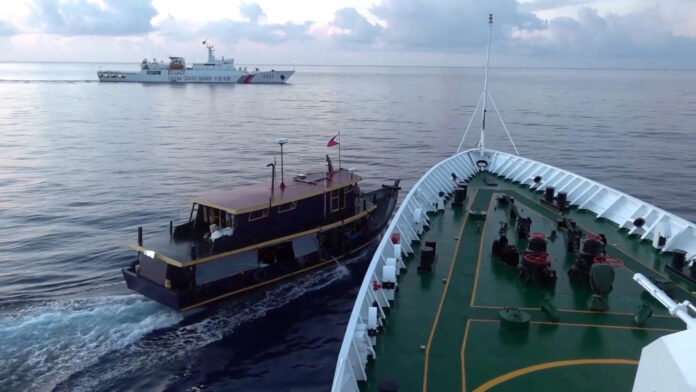The escalating tensions between China and the Philippines in the South China Sea represent a worrisome flashpoint in a region already fraught with geopolitical complexities. The South China Sea, a hotbed of territorial disputes, is increasingly becoming a focal point for superpower competition, with the USA supporting the Philippines in asserting its claims.
The Philippine coastguard, under President Ferdinand Marcos Jr’s directives, has recently dismantled a floating barricade placed by China at the disputed Scarborough Shoal, historically known as Huangyan Island, in the South China Sea. This move was prompted by the Philippines’ vehement objections to the barrier’s presence, deeming it a violation of international law and an impediment to regional navigation and fishing activities. This development underscores the potential for heightened regional tensions, long fueled by disputes over sovereignty and fishing rights.
The South China Sea plays a pivotal role in global trade, serving as a vital maritime route for approximately one-third of worldwide shipping, facilitating the transportation of goods like oil, natural gas, and consumer products between the Pacific and Indian Oceans. Disputes in this region have the potential to disrupt these critical trade routes, leading to shipping delays, increased transportation costs, and potential disruptions in global supply chains. Additionally, the South China Sea holds significant fisheries and substantial oil and gas reserves, making territorial disputes directly impact these economic resources, affecting the livelihoods of many in the region and posing energy security concerns for multiple countries.
This incident transpired amidst a backdrop of escalating tensions between China and the Philippines, notably centred on the disputed Spratly Islands. China’s extensive territorial claims, encompassing approximately 90 percent of the South China Sea, have led to overlapping exclusive economic zones with Vietnam, Malaysia, Brunei, Indonesia, and the Philippines.
In 2012, China took control of the Scarborough Shoal, displacing Filipino fishermen. Under Rodrigo Duterte’s presidency, China allowed them to return, but tensions resurfaced when Ferdinand Marcos Jr assumed office. China recently removed a barrier blocking Filipino fishermen from their exclusive economic zone, prompting a warning from Beijing. Despite a 2016 ruling in favour of the Philippines by the Permanent Court of Arbitration, China refuses to acknowledge the decision, maintaining its territorial claims.
The China-Philippines conflict in the South China Sea serves as a critical litmus test for international diplomacy, regional stability, and the potential for superpower showdowns. As tensions persist and strategic alliances solidify, the world finds itself at a crossroads, confronted by a pressing question: Can peaceful negotiations ultimately triumph in the face of competing national interests and global power rivalries or are we witnessing the inception of a new era of superpower competition, the full scope of which is yet to be fully comprehended? The answer to this question holds immense significance, not just for the directly involved nations, but for the intricate balance of power in an ever-evolving international arena.
China’s Foreign Ministry has defended the actions of its coastguard as “necessary measures” following the alleged intrusion of a Philippine bureau of fisheries vessel into its waters on Friday. This exchange of accusations highlights the strained relations between China and the Philippines, occurring as Manila deepens its military ties with the USA, a move that has raised tensions with Beijing. Since 2012, the Scarborough Shoal, of strategic significance, has remained under Chinese control with a continuous presence of coast guard and fishing trawlers. The Philippines’ recent shift back to strengthening security ties with the USA under President Ferdinand Marcos Jr has further strained relations with China, as it bolsters Washington’s regional alliance network from Japan and South Korea in the north to Australia in the south.
Under the leadership of former President Rodrigo Duterte, the Philippines had maintained a relatively peaceful coexistence between Chinese and Filipino fishermen at the Scarborough Shoal since 2017. However, recent tensions have arisen due to China’s installation of a floating barrier at the shoal, viewed by the Philippines as a violation of international law and a threat to its sovereignty and the livelihood of its fisherfolk.
China’s recent extensive land reclamation efforts in the South China Sea, particularly in the Spratly Islands, have entailed the construction of artificial islands with military infrastructure like airstrips, radar systems, and missile defences. This has significantly bolstered China’s military presence in the region, leading neighbouring countries to respond with increased military activities. The USA has conducted Freedom of Navigation Operations (FONOPs) challenging China’s maritime claims, resulting in frequent encounters between US and Chinese naval forces, while countries like Vietnam and the Philippines, with South China Sea claims, have also enhanced their military capabilities and conducted patrols to protect their interests.
The South China Sea dispute has fueled intensified strategic competition across the Indo-Pacific. Concerns over China’s growing influence have driven the USA, Australia, Japan and India to bolster ties with nations like the Philippines and Vietnam, resulting in a network of alliances aimed at countering China’s regional dominance. Through military cooperation, joint exercises, and increased defence commitments, these nations strive to ensure regional stability and uphold international norms, particularly concerning the South China Sea disputes. The US defence treaty with the Philippines further compounds the situation, obligating US intervention in the event of conflict, and potentially transforming a regional dispute into a superpower standoff.
The active engagement of the USA in the South China Sea issue reflects its commitment to upholding a rules-based international order in the Indo-Pacific region. It has expressed legitimate concerns about China’s influence and territorial expansion, which could disrupt regional stability and freedom of navigation. Moreover, the USA has conducted military exercises to ensure open commerce and strengthen alliances with like-minded nations, reaffirming its role as a responsible global leader committed to peace and stability amid evolving geopolitical challenges in the Indo-Pacific.
In retrospect, the China-Philippines conflict in the South China Sea serves as a critical litmus test for international diplomacy, regional stability, and the potential for superpower showdowns. As tensions persist and strategic alliances solidify, the world finds itself at a crossroads, confronted by a pressing question: Can peaceful negotiations ultimately triumph in the face of competing national interests and global power rivalries or are we witnessing the inception of a new era of superpower competition, the full scope of which is yet to be fully comprehended? The answer to this question holds immense significance, not just for the directly involved nations, but for the intricate balance of power in an ever-evolving international arena.






















